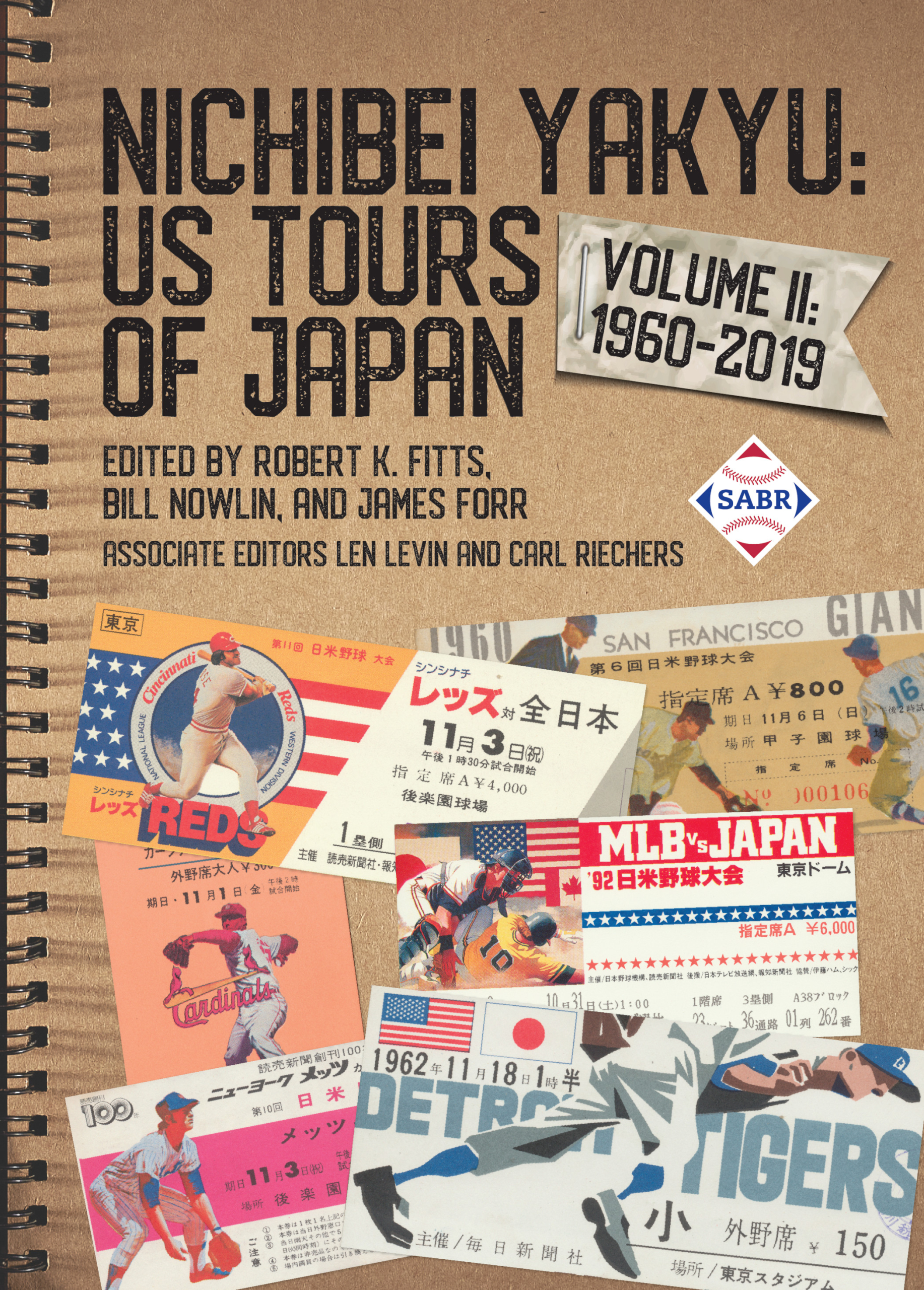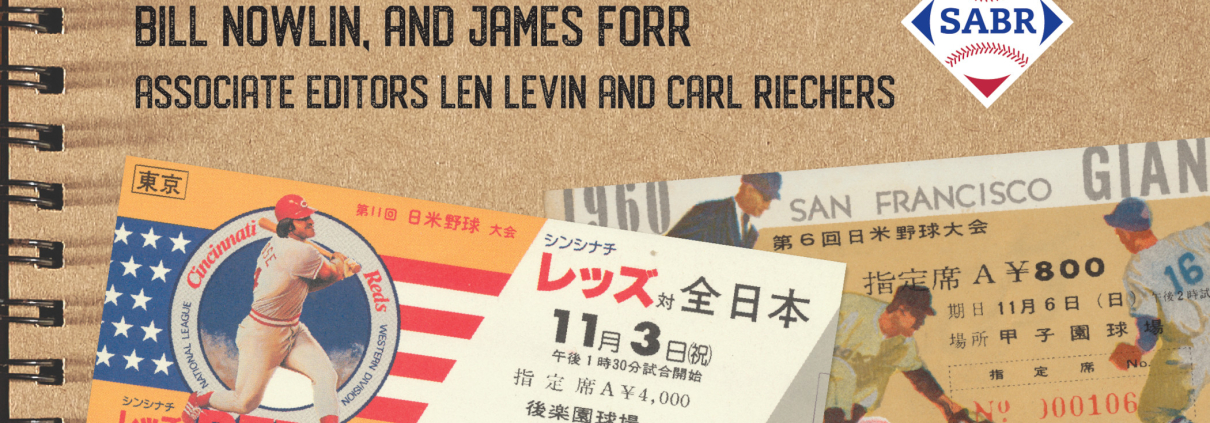Introduction: Nichibei Yakyu: US Tours of Japan, 1960-2019
This article was written by Rob Fitts
This article was published in Nichibei Yakyu: US Tours of Japan, 1960-2019
 The year 2022 marked the official 150th anniversary of Japanese baseball. Tradition states that Horace Wilson, a baseball fanatic from Gorham, Maine, introduced the game in 1872 to his students at Daiichi Daigaku (renamed Kaisei Gakko the following year). Since that time, the United States and Japan’s shared love of baseball has spawned thousands of individual friendships and helped bring the nations together during times of peace, conflict, and reconciliation.
The year 2022 marked the official 150th anniversary of Japanese baseball. Tradition states that Horace Wilson, a baseball fanatic from Gorham, Maine, introduced the game in 1872 to his students at Daiichi Daigaku (renamed Kaisei Gakko the following year). Since that time, the United States and Japan’s shared love of baseball has spawned thousands of individual friendships and helped bring the nations together during times of peace, conflict, and reconciliation.
Beginning in 1907, more than 100 North American and Hawaiian ballclubs have crossed the Pacific to promote the game and further international goodwill (Table 1). These series are known in Japan as Nichibei Yakyu. Nichibei means “Japan and the US” derived from the first kanji used to write Japan ( ) and the United States of America (
) and the United States of America ( ).
).  is read as nichi,
is read as nichi,  as bei. Yakyu is the Japanese name for baseball. Despite their importance to baseball history and international diplomacy, there is no comprehensive book that focuses on tours of Japan. Nichibei Yakyu: US Tours of Japan volumes I and II fill that gap.
as bei. Yakyu is the Japanese name for baseball. Despite their importance to baseball history and international diplomacy, there is no comprehensive book that focuses on tours of Japan. Nichibei Yakyu: US Tours of Japan volumes I and II fill that gap.
Nichibei Yakyu: US Tours of Japan, Volume I: 1907-1958 covers the tours between 1907 and 1959. It contains chapters on all 14 of the professional teams plus selected college, amateur, and semipro squads that played in Japan during this period. Each chapter is accompanied by game results and, when available, player statistics. Nichibei Yakyu: US Tours of Japan, Volume II: 1960-2019 covers the 29 major-league teams that played in Japan between 1960 and 2019. Game results and player statistics are included for each of these tours.
Each tour is far more complicated than can be explored in the short space allowed in this volume. So these chapters are just summaries. We hope that readers will use these essays as starting points for further research. Furthermore, as most of the authors do not read Japanese, the majority of chapters rely only on English-language sources. We encourage future researchers to delve into sources available in Japan to get a fuller picture of these tours and understand the Japanese perspective.
Throughout these volumes, Japanese names are written in Western style – given name followed by family name – as opposed to Japanese style, in which the family name comes first. Readers should also be aware that, especially before 1950, Japanese sometimes changed the way their given names are pronounced. Kanji can usually be read and pronounced in at least two ways: kun’yomi (Japanese reading) and on’yomi (Chinese reading). Prior to World War II, many Japanese would use both pronunciations of their first name, the choice depending on the social situation. Usually players settled on one name when on the diamond but sometimes a player would decide to change his first name. To aid readers, we have used the same first name for each person throughout these volumes, even when a person has changed his name between seasons. For example, Waseda University player and manager Chujun Tobita is always called Chujun (his on’yomi pronunciation, which he used as a college player) rather than Tadayori (his kun’yomi pronunciation, which he used later in life). We have made one exception to this rule. In the endnotes, we use the first name the author used at the time of publication. So, in the endnotes, Chujun Tobita is often listed as Suishu Tobita (his usual pen name).
In the first half of the twentieth century, Japan’s public educational system differed from the system used in the United States. After compulsory primary school for all children, selected students between the ages of 12 and 17 attended middle schools. The top middle-school graduates often went on to one of the elite higher schools for three years before attending college. Touring American amateur baseball clubs regularly played Japanese middle-school teams. For the ease of North American readers, in these volumes we refer to Japanese middle schools as high schools, since the student players were about the same age as American high schoolers.
Readers should also note that until recently American newspapers used language and terms now recognized as derogatory and demeaning. An effort has been made not to perpetuate the use of this language except when these terms’ use in a direct quote is unavoidable or provides insight to the speaker’s mindset.
Many people have helped make this project possible. We would like to thank Bill Staples Jr., who first suggested that a book on the tours of Japan would make a good SABR project. Yoichi Nagata and Yusuke Suzumura helped with Japanese-language sources and provided many of the first names of Japanese college players not listed in English-language sources. Carl Riechers and James Forr did outstanding jobs fact-checking the articles. Carter Cromwell proofread the chapters. Finally, Len Levin painstakingly copy-edited each chapter.
ROBERT K. FITTS is the author of numerous articles and seven books on Japanese baseball and Japanese baseball cards. Fitts is the founder of SABR’s Asian Baseball Committee and a recipient of the society’s 2013 Seymour Medal for the Best Baseball Book of 2012 (Banzai Babe Ruth); the 2019 McFarland-SABR Baseball Research Award; the 2012 Doug Pappas Award for the best oral research presentation at the annual convention; and the 2006 and 2021 SABR Research Awards. He has twice been a finalist for the Casey Award and has received two silver medals at the Independent Publisher Book Awards. While living in Tokyo in 1993-94, Fitts began collecting Japanese baseball cards and now runs Robs Japanese Cards LLC. Information on Rob’s work is available at RobFitts.com.
- Read more: Find all essays from Nichibei Yakyu, Volume 2 in the SABR Research Collection online
- E-book: Click here to download the e-book version of Nichibei Yakyu, Volume 2 for FREE from the SABR Store. Available in PDF, MOBI, EPUB/Kindle formats.
- Paperback: Get a 50% discount on paperback edition from the SABR Store ($24.95 includes shipping/tax; delivery via Amazon Kindle Direct can take up to 4-6 weeks.)
Table 1: List of all known tours of Japan by North American and Hawaiian teams before 1945 and all teams from Organized Baseball after 1945
- 1907: St. Louis Hawaii
- 1908: Reach All-Americans
- 1908: University of Washington
- 1909: University of Wisconsin
- 1910: University of Chicago
- 1913: Giants-White Sox
- 1913: Stanford University
- 1913: Hawaii Japanese School (Hawaii Chugaku)
- 1913: University of Washington
- 1914: Seattle Asahi
- 1914: Seattle Nippon
- 1915: Honolulu Asahis
- 1915: University of Chicago
- 1916: St. Louis Hawaii
- 1918: Seattle Asahi
- 1920: Honolulu Asahis
- 1920: Seattle Mikado
- 1920: Gene Doyle’s All-Stars
- 1920: University of Chicago
- 1921: Suquamish Indians
- 1921: Canadian Stars
- 1921: Hawaii All-Stars
- 1921: Seattle Asahi
- 1921: Vancouver Asahi
- 1921: Sherman Indians
- 1921: University of California, Berkeley
- 1921: University of Washington
- 1921: Hawaiian Nippon
- 1921: Hawaiian Hilo
- 1922: Herb Hunter’s All-Americans
- 1922: Indiana University
- 1922: San Francisco Collegians
- 1923: Seattle Asahi / Mikados
- 1924: Fresno Athletic Club
- 1925: Philadelphia Bobbies
- 1925: San Jose Asahi
- 1925: University of Chicago
- 1925: Sacramento Nippon
- 1926: Honolulu Asahis
- 1926: Stanford University
- 1925: University of Washington
- 1927: Fresno Athletic Club
- 1927: Philadelphia Royal Giants
- 1927: University of California, Berkeley
- 1928: Ty Cobb
- 1928: Aratani Guadalupe
- 1928: Stockton Yamato
- 1928: University of Illinois
- 1928: University of Southern California
- 1928: McKinley High School of Honolulu
- 1929: University of Michigan
- 1929: University of California, Berkeley
- 1930: Seattle Taiyo Athletic Club
- 1930: University of Chicago
- 1931: Kono Alameda All-Stars
- 1931: Los Angeles Nippons
- 1931: Major League All-Stars
- 1932: Hunter, O’Doul, Lyons & Berg
- 1932: Philadelphia Royal Giants
- 1932: University of Michigan
- 1928: University of Hawaii
- 1932: Athens (California) Athletic Club
- 1932: Honolulu Braves
- 1933: Honolulu Asahis
- 1934: Harvard University
- 1934: All-Americans
- 1935: Wheaties All Americans
- 1935: Yale University
- 1936: Honolulu Braves
- 1937: Kono Alameda All-Stars
- 1940: Honolulu Asahis
- 1949: San Francisco Seals
- 1950: DiMaggio & O’Doul
- 1951: Lefty O’Doul All-Stars
- 1953: Eddie Lopat All-Stars
- 1953: New York Giants
- 1955: New York Yankees
- 1956: Brooklyn Dodgers
- 1958: St. Louis Cardinals
- 1960: San Francisco Giants
- 1962: Detroit Tigers
- 1966: Los Angeles Dodgers
- 1968: St. Louis Cardinals
- 1970: San Francisco Giants
- 1971: Baltimore Orioles
- 1974: New York Mets
- 1978: Cincinnati Reds
- 1979: AL&NL All-Stars
- 1981: Kansas City Royals
- 1984: Baltimore Orioles
- 1986: Major League All-Stars
- 1988: Major League All-Stars
- 1990: Major League All-Stars
- 1992: Major League All-Stars
- 1993: Los Angeles Dodgers
- 1996: Major League All-Stars
- 1998: Major League All-Stars
- 2000: Mets & Cubs
- 2000: Major League All-Stars
- 2002: Major League All-Stars
- 2004: Yankees & Rays
- 2004: Major League All-Stars
- 2006: Major League All-Stars
- 2008: Athletics & Red Sox
- 2012: Mariners & A’s
- 2014: Major League All-Stars
- 2018: Major League All-Stars
- 2019: Mariners & A’s


